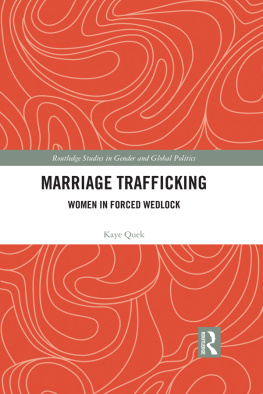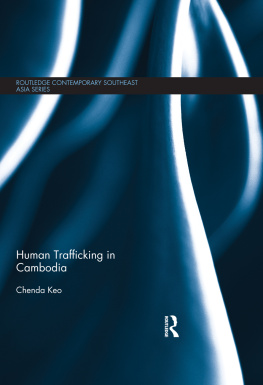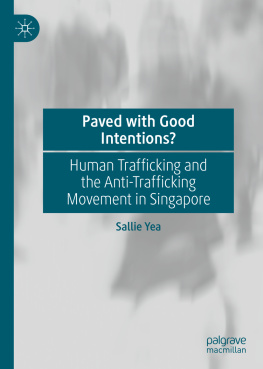HUMAN TRAFFICKING AROUND THE WORLD
Human Trafficking Around the World
Hidden in Plain Sight
STEPHANIE HEPBURN and RITA J. SIMON

Columbia University Press
New YorkColumbia University Press
Publishers Since 1893
New York Chichester, West Sussex
cup.columbia.edu
Copyright 2013 Columbia University Press
All rights reserved
E-ISBN 978-0-231-53331-7
Library of Congress Cataloging-in-Publication Data
Hepburn, Stephanie, 1977
Human trafficking around the world : hidden in plain sight / Stephanie Hepburn and Rita J. Simon.
pages cm.
Includes bibliographical references and index.
ISBN 978-0-231-16144-2 (cloth : alk. paper)ISBN 978-0-231-16145-9 (paperback : alk. paper)ISBN 978-0-231-53331-7 (e-book)
1. Human trafficking. I. Simon, Rita J. (Rita James), 1931 II. Title.
K5297.H47 2013
364.15dc23
2013000561
A Columbia University Press E-book.
CUP would be pleased to hear about your reading experience with this e-book at .
COVER IMAGE: Getty Images
COVER DESIGN: Julia Kushninsky
References to Internet Web sites (URLs) were accurate at the time of writing.
Neither the author nor Columbia University Press is responsible for URLs that may have expired or changed since the manuscript was prepared.
To our families and friends for the steadfast support they have shown us, and most importantly to the victims of human trafficking who have existed in darkness for far too long.
They would not call it slavery, but some other name. Slavery has been fruitful in giving itself names. It has been called the peculiar institution, the social system, and the impediment, as it was called by the General Conference of the Methodist Episcopal Church. It has been called by a great many names, and it will call itself by yet another name; and you and I and all of us had better wait and see what new form this old monster will assume, in what new skin this old snake will come forth.
FREDERICK DOUGLASS, SPEECH TO THE AMERICAN ANTI-SLAVERY SOCIETY, MAY 1865
Contents
We have all seen films that portray the dark and lurid world of human trafficking, depictions that seem sensationalized and exaggerated for cinematic effect. The victims are usually young women forced into an underground sex-trafficking ring, kept on a permanent drug high, and forced to prostitute. Although the plot is horrifying, it is just a story to usor perhaps it is something that happens in some other part of the world but surely would never occur where we live. Yet the reality is that wherever we may live, regardless of city or nation, some form of human trafficking exists. As of 2005 this global phenomenon reaped an annual worldwide profit of $44.3 billion and affected more than 12.3 million persons. The International Labour Organization (ILO) estimated that 43 percent of victims were trafficked for commercial sexual exploitation, 32 percent were trafficked for forced labor, and the remaining 25 percent were trafficked for a mixture of both or for undetermined reasons (Belser, 2005, p. 4; ILO, 2006). We believed the percentage of forced labor to be higher, and recent ILO global estimates concur. The International Labour Organization now estimates that 20.9 million are victims of forced labor. Within that number it is estimated that 14.2 million people (68 percent) are victims of forced labor exploitation and 4.5 million (22 percent) are victims of forced sexual exploitation. The remainder of victims2.2 million (10 percent)are in state-imposed forms of forced labor such as that imposed by rebel armed forces, state militaries, and prisons with conditions that conflict with ILO standards (ILO, 2012, p. 13).
The term human trafficking triggers preconceived notions. Sex trafficking has received more coverage in the media than forced labor, so people generally think of it. But it is the element of movement that seems to confuse most, even legislators. The verb traffic, according to Merriam-Webster, means to trade or barter. Yet trade in humans does not necessarily involve movement, and international definitions of human trafficking are evolving to include this fact. The crux of human trafficking is its exploitative purpose. Persons of all ages and genders are vulnerable. Women and girls make up 56 percent of persons trafficked for forced labor, while men and boys make up 44 percent. Of those trafficked for forced commercial sexual exploitation, women and girls make up 98 percent; men and boys make up 2 percent. Children constitute 40 to 50 percent of the overall forced labor population (Belser, 2005). While trafficking for forced labor is more prevalent than sex trafficking, many nations are just beginning to include forced labor in their anti-trafficking legislation and statistics. Although we perceive all forms of indentured servitude to be forced labor, a division is often created in legal definitions and anti-trafficking legislation. As a result, throughout the book trafficking for forced labor and for commercial sexual exploitation are presented as two different categories. Other forms of trafficking will also be discussed, such as organ trafficking and Muti murders, which involve killing a person and removing the body parts and organs that are allegedly used for traditional healing purposes. Child sexual tourism, adoption, and marriage for the purpose of sexual exploitation are also examined.
Human trafficking varies not only by type but also by current, that is, by the flow of victims. These currents are categorized in terms of source nation, transit nation, and destination nation. Many nations qualify for all these groupings, but one category is often more prevalent than the others. Another current of trafficking, one that is often ignored, is purely internal or domestic, involving indentured servitude within a nation. Because the anti-trafficking focus has been chiefly on victims of international trafficking, internal trafficking is often absent from the calculus, both in legislation and in practice.
There are common methods used by traffickers, regardless of the type of trafficking, such as false job offers that lure potential victims and exorbitant fees charged for recruitment, visas, travel, housing, food, and the use of tools. These practices keep victims in an endless cycle of debt. Along these same lines, traffickers often charge victims fines for alleged poor behavior or not meeting certain work quotas. As debts rise exponentially, victims often go unpaid or are underpaid. In order to control and limit the movement of victims, traffickers frequently withhold victims visas and other identifying documentation, isolate the victims, threaten deportation, threaten to harm the victims or their families, and physically harm the victims. At the beginning of the process, exorbitant recruiting fees, sometimes as high as $40,000, can place victims in a position of debt bondage. In order to pay these fees workers sell their land or that of family members and take out loans with astronomical interest rates. Earning low wages or none and paying high fees for housing, food, and even the use of work tools, the workers can never catch up to their debt, putting them in a position of debt bondage. In cases where the employer paid the costs, the worker is told that before they can receive their wages they have to work off the fees.
There are many definitions of human trafficking, but the Palermo Protocol, otherwise known as the United Nations Protocol to Prevent, Suppress, and Punish Trafficking in Persons, Especially Women and Children, is the worldwide standard for anti-trafficking law and the template on which many nations model their domestic laws. The protocol, which supplements the 2000 United Nations Convention against Transnational Organized Crime, contains three elements that define trafficking of persons. The first element is the act of trafficking, which is the recruitment, transportation, transfer, harboring, or receipt of persons. The second, the means of trafficking, is the threat or use of force or other forms of coercion, abduction, fraud, deception, abuse of power or vulnerability, or giving payments or benefits to a person in control of the victim. The third, the purpose of trafficking, is exploitation. This includes, at a minimum, sexual exploitation, including the exploitation of the prostitution of others, forced labor or services, slavery or practices similar to slavery, servitude, or the removal of organs (UNODC, 2004, p. 42). Of the 24 nations we examined, 21 have ratified the protocol, in whole or in part: Australia, Brazil, Canada, Chile, China, Colombia, France, Germany, India, Iraq, Israel, Italy, Mexico, Niger, Poland, Russia, South Africa, Syria, the United Arab Emirates, the United Kingdom, and the United States. Iran, Japan, and Thailand have not yet ratified the protocol (UNTC, 2011). Ratification of the protocol alone is not a sufficient anti-trafficking measure for a nation. The Palermo Protocol, according to Joy Ngozi Ezeilo, United Nations special rapporteur on trafficking in persons, is not a self-executing provision (OHCHR, 2009); that is, by itself the protocol is not sufficient to bridge the gap between domestic and international law. Those nations that ratify the protocol must also adopt domestic anti-trafficking law, or an additional act of legislation, to harmonize internal legislation to that of the protocol and ensure that the protocol is entirely implemented. Consequently, gauging a nations anti-trafficking efforts solely on whether they have ratified the protocol is not adequate.








 Columbia University Press New York
Columbia University Press New York